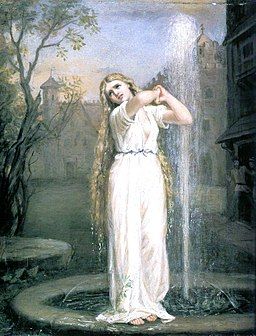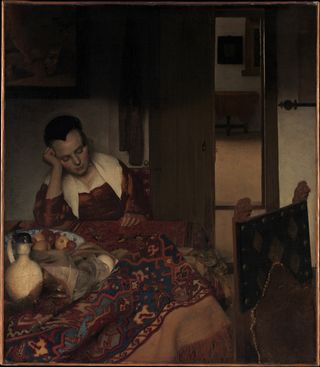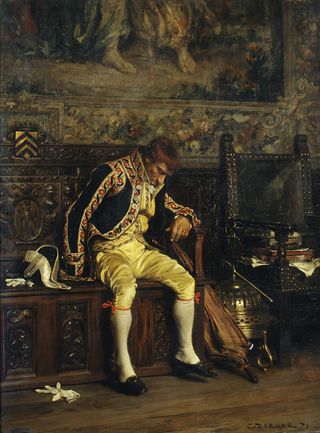Sleep
Sleepers Awake! Obstructive Sleep Apnea
Poetic license in the study of sleep-related breathing disorders
Posted March 9, 2018

There is a tale in 19th century European folklore about the supernatural water sprite, Ondine, who falls in love with the knight-errant, mortal Hans. In one account, Ondine is warned that Hans will ultimately betray her and return to his betrothed Bertha, who had sent him out on his quest. A curse is put on Hans: if he ever deceives Ondine, he will die. Torn between his love for Ondine and his love for Bertha, Hans ultimately chooses Bertha, and the curse takes effect: when he falls asleep, he "forgets" to breathe and dies. The story has been immortalized in a 1930s play by Jean Giraudoux (Olry and Haines, Journal of the History of the Neurosciences, 2017) and a 19th century painting by John William Waterhouse. The moral: don't transgress the bounds of nature. Is the Academy Award-winning film, The Shape of Water, a somewhat more sanguine, science fiction version of this story?
Ondine's curse is also the eponym given to one of the "strangest diseases in the history of neurology," i.e., the central ventilation syndrome. (Olry and Haines, 2017) It is one of the sleep-related breathing disorders, extremely rare (1/200,000 births) and potentially deadly, usually caused by an autosomal dominant genetic mutation, but can also be caused by severe trauma or tumor to the brainstem. Patients have impaired autonomic control of breathing, with a loss of sensitivity to carbon dioxide chemo-receptors so that they actually do "forget to breathe" during sleep but maintain normal control of their breathing while awake. (Zaidi et, Autonomic Neuroscience, 2017) With newer, advanced techniques that can monitor sleep, those who manifest symptoms in infancy can now survive into adulthood.(Suslo et al, Advances in Experimental Medicine and Biology, 2015) Anesthesiologists have sometimes used the eponym, Ondine's curse, as well, to refer to an unexplained and unexpected unconsciousness and hypoventilation that occurs in patients after they had initially awakened from anesthesia. (Suslo et al, 2015)

Another sleep-related breathing disorder also has an eponym, the Pickwickian syndrome, named for a character in Charles Dickens', The Posthumous Papers of the Pickwick Club (1837.) Though references to obesity and disordered breathing had occurred from the time of Hippocrates (Kryger, Archives of Internal Medicine, 1983), it was Burwell and his colleagues, in a classic 1956 paper, who labeled a syndrome of extreme obesity associated with hypoventilation the Pickwickian syndrome (reprinted, Obesity Research, 1994.) These patients, just like Joe, Dickens' "fat and red-face boy," who snored loudly and could not seem to stay awake, have an "extraordinary degree of somnolence in which sleep may overcome them while they are sitting up or even engaged in conversation." (Burwell et al, 1994, reprinted.) Clinical features for these researchers included marked obesity, somnolence, twitching, cyanosis, periodic respiration, secondary polycythemia, right ventricular hypertrophy, and right ventricular failure, with a resulting high blood level of carbon dioxide (hypercapnia) and low levels of oxygen.

Not everyone has agreed with Burwell et al's diagnosis of the Dickens' character, and clinically, there has been controversy regarding what really constitutes the Pickwickian syndrome: some describe the term "as an erratic terminology of scientific expression and more justified by poetic license than ..medical precision." (Rössner, Obesity Reviews, 2012) Since Joe had a red face (possibly due to polycythemia) and dropsy (the old word for edema), he may have had cor pulmonale, but physicians over the years have considered endocrine or hypothalamic disorders and even the Prader-Willi syndrome. (Kryger, Journal of Clinical Sleep Medicine, 2012) Today, the Pickwickian syndrome is synonymous with the obesity hypoventilation syndrome (OHS), as manifested by obesity, chronic daytime hypercapnia, and sleep-disordered breathing, with snoring. (Liu et al, Oncotarget, 2017) It may present with acute hypercapnic respiratory failure and hence may be misdiagnosed as chronic obstructive pulmonary disease. (Liu et al, 2017) In patients with this syndrome, they may have increased morbidity, with the development of hypertension, diabetes, atrial fibrillation, or even heart failure. Its prevalence ranges from 9 to 20% in those referred obese patients. (Pierce and Brown, Current Opinion in Pulmonary Medicine, 2015) Their upper airway may collapse not only while reclining in sleep, but also when they are sitting. (Liu et al, 2017) OHS is more common in postmenopausal obese women, who have more "deranged blood gases" and have more comorbidities than men, and may go unrecognized. (Piper et al, Sleep Medicine Clinics, 2017) Delivering positive air pressure via mask will alleviate the sleep disordered breathing and increased blood carbon dioxide but patients are strongly encouraged to undergo weight loss and increase physical exercise. (Piper et al, 2017)

The most common sleep-related breathing disorder, though, is obstructive sleep apnea (OSA), which sometimes coexists with the obesity hypoventilation syndrome. The vast majority of patients with OHS will have comorbid obstructive sleep apnea. When OSA occurs independently, there are impaired episodes of breathing only during sleep, when the patient's upper airway collapses, and not during the day. (Liu et al, 2017)
Estimates of the prevalence of OSA vary due to differences in what constitutes severity, but reportedly 9 to 49% of middle-age men and 3 to 23% of women will have "moderate to severe" episodes of apnea, as defined by more than 15 apneic episodes per hour during sleep. The apnea-hypopnea index (AHI) is the standard scale, though "an inadequate metric" for classifying OSA since it is "extremely limited" in predicting future clinical outcomes. (Sutherland et al, 2018, Expert Review of Respiratory Medicine, 2018) Greater than 30 episodes per hour is usually considered severe. By far, the major risk factor is obesity, but 20% of those diagnosed with OSA are not obese, and these patients can be more difficult to treat. (Gray et al, Journal of Clinical Sleep Medicine, 2017) Anatomical features, such as a thick neck, narrow pharyngeal airway, or even fat accumulation on the tongue, can predispose a person to OSA.(Osman et al, Nature and Science of Sleep, 2018) The diagnosis should be suspected in someone who has loud nightly snoring, daytime sleepiness, and obesity, but the "gold standard" for diagnosis is made in a sleep lab by polysomnography. OSA is also seen in children, particularly when they have obesity or enlarged tonsils and adenoids. (Andersen et al, International Journal of Pediatric Otorhinolaryngology, 2016)
There is perhaps fanciful speculation that some famous people, including Brahms (of Brahms Lullaby), (Margolis, Chest 2000) and Queen Victoria (Conti et al, Medical Hypotheses, 2006) may have had undiagnosed OSA. President William Howard Taft may have had it as well. Taft reportedly could fall asleep in the middle of important conversations, had loud snoring, a thick neck, hypertension, cognitive "fogginess," and a body mass index (BMI) of 42. (Sotos, Chest, 2003) OSA is apparently not uncommon among some hefty players and retired players in the National Football League. (George et al, NEJM, 2003; Luyster et al, Nature and Science of Sleep, 2017)

Obstructive sleep apnea is characterized by the "periodic narrowing and obstruction of the pharyngeal airway" that can occur because the "human pharynx is unique in that it lacks a bony support" and hence is vulnerable to collapse during sleep. (Osman et al, 2018) It results in hypoxia and even surges in blood pressure during sleep, as well as excessive daytime sleepiness, sleep fragmentation and non-restful sleep, irritability, memory loss and cognitive impairment, morning headache, depression, and even an increased risk of car accidents. (Osman et al, 2018) It is associated with "downstream" morbidity, with increased risk of cardiovascular disease and metabolic abnormalities. (Sutherland et al, 2018) Further, any patient being considered for bariatric surgery should be screened for OSA and OHS because of possible peri-operative complications, and pain medications that decrease respiration (e.g. opioids) should be avoided. (de Raaff et al, Current Opinion in Anesthesiology, 2018)
The primary treatment for both obstructive sleep apnea and obesity hypoventilation syndrome is continuous positive airway pressure (CPAP) delivered by a mask, but difficulty with the "mask interface" is common and leads to non-compliance with treatment recommendations that include long-term, nightly use for the entire night. Even those "compliant" sometimes use it for only four hours a night. (Dibra et al, Sleep Medicine Clinics, 2017) Some patients feel claustrophobic and others fail to comply out of embarrassment. There are many choices of mask, and patients are encouraged to try different ones. If the mask does not fit properly, patients can get eye and skin irritation, and air leakage.

Bottom line: There are many breathing disorders associated with sleep. The most common is obstructive sleep apnea (OSA). The diagnosis should be considered whenever a patient has obesity, daytime sleepiness, heavy snoring at night, and observed (by partner) apneic episodes during sleep, though it can occur in the non-obese and in children. CPAP, if used as prescribed, is helpful for the breathing difficulties, but most clinicians recommend interventions for weight loss in those patients who are obese. OSA can lead to cardiovascular disease and metabolic abnormalities. Once cardiovascular disease develops, though, studies suggest that CPAP will not necessarily prevent future "cardiovascular events." (McEvoy et al, NEJM, 2016)
The musical scholars among you will know my title comes from Bach's Cantata 140, Sleepers Awake!




